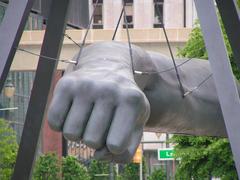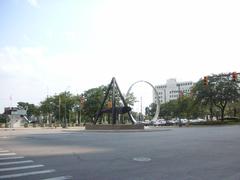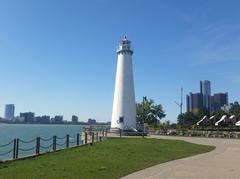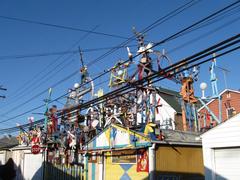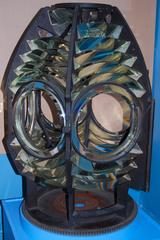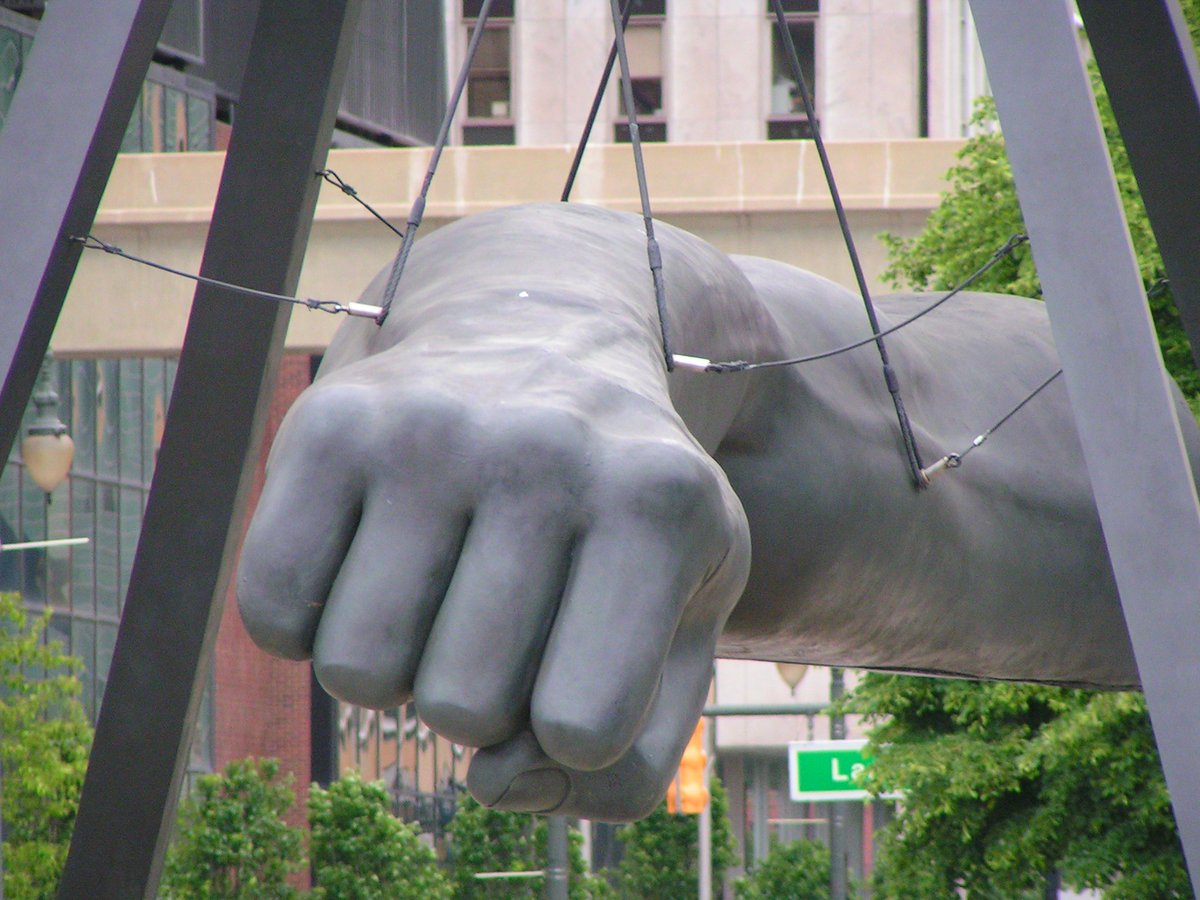
Comprehensive Guide to Visiting the Monument to Joe Louis in Detroit, United States
Date: 31/07/2024
Introduction
The Monument to Joe Louis, renowned as ‘The Fist,’ is an iconic sculpture located in the heart of Detroit, Michigan. This monument serves as a powerful homage to Joe Louis, a legendary African American boxer whose influence transcended the boxing ring and left an indelible mark on American society. Commissioned by Sports Illustrated Magazine and crafted by distinguished sculptor Robert Graham, the sculpture was dedicated on October 16, 1986 (Wikipedia). Standing at the intersection of Jefferson Avenue and Woodward Avenue, the 24-foot-long bronze forearm and fist suspended by a pyramidal framework is not just a tribute to Louis’s athletic prowess but also a profound symbol of the fight against racial injustice.
Joe Louis, the ‘Brown Bomber,’ held the World Heavyweight Champion title from 1937 to 1949 and is celebrated for his role in breaking racial barriers in America (Daily Detroit). His iconic victory over German boxer Max Schmeling in 1938 was seen as a symbolic triumph over Nazi ideology, providing a sense of hope and pride for African Americans and marginalized communities. The clenched fist of the monument embodies Louis’s strength, determination, and unwavering fight against racism, making it a significant cultural and historical landmark (Travel-Mi).
This comprehensive guide delves into the history, significance, and visitor information of the Monument to Joe Louis, offering insights into its design, cultural impact, and practical tips for those wishing to explore this poignant symbol of resilience and equality.
Table of Contents
- [History of the Monument to Joe Louis](#history-of-the-monument-to-joe-louishistory-of-the-monument-to-joe-louis)
- [Commission and Dedication](#commission-and-dedicationcommission-and-dedication)
- [Design and Construction](#design-and-constructiondesign-and-construction)
- [Symbolism and Cultural Impact](#symbolism-and-cultural-impactsymbolism-and-cultural-impact)
- [Controversies and Public Perception](#controversies-and-public-perceptioncontroversies-and-public-perception)
- [Historical Context](#historical-contexthistorical-context)
- [Legacy and Recognition](#legacy-and-recognitionlegacy-and-recognition)
- [Visitor Information](#visitor-informationvisitor-information)
- [Visiting Hours and Tickets](#visiting-hours-and-ticketsvisiting-hours-and-tickets)
- [Nearby Attractions](#nearby-attractionsnearby-attractions)
- [Accessibility](#accessibilityaccessibility)
- [Travel Tips](#travel-tipstravel-tips)
- [Frequently Asked Questions (FAQ)](#frequently-asked-questions-faqfrequently-asked-questions-faq)
- [Conclusion](#conclusionconclusion)
History of the Monument to Joe Louis
Commission and Dedication
The Monument to Joe Louis, also known as “The Fist,” was commissioned by Sports Illustrated Magazine and created by the Mexican-American sculptor Robert Graham. The sculpture was dedicated on October 16, 1986, and stands prominently at the intersection of Jefferson Avenue and Woodward Avenue in Detroit, near Hart Plaza (Wikipedia). The dedication ceremony marked a significant moment for the city, celebrating both the legacy of Joe Louis and the cultural importance of the artwork.
Design and Construction
The sculpture is a 24-foot-long (7.3 meters) cast bronze forearm and fist, suspended by a 24-foot-high (7.3 meters) pyramidal framework. The entire structure weighs 8,000 pounds, with the arm itself weighing 5,000 pounds (The Clio). The bronze casting was executed by the renowned artist Rolf Kriken, adding to the sculpture’s artistic and historical value. The cost of the monument was $350,000, funded by a grant from Sports Illustrated (Travel-Mi).
Symbolism and Cultural Impact
The Monument to Joe Louis is not just a tribute to the boxer’s prowess in the ring but also a powerful symbol of the fight against racial injustice. Joe Louis, who was the World Heavyweight Champion from 1937 to 1949, is celebrated for his significant role in breaking racial barriers in America. His victory over German boxer Max Schmeling in 1938 was seen as a symbolic defeat of Nazi ideology and a triumph for racial equality (Daily Detroit).
The sculpture’s design, featuring a clenched fist, represents the strength and determination of Joe Louis both inside and outside the boxing ring. It is intended as a statement against racism and a reminder of Louis’s efforts to combat Jim Crow laws (Wikipedia). The placement of the fist, pointing towards Canada, is also seen as a historical metaphor, symbolizing the broader struggle for freedom and justice (Wikipedia).
Controversies and Public Perception
Since its installation, the Monument to Joe Louis has been a subject of controversy and debate. In 2004, the sculpture was vandalized by two white men who covered it in white paint and left a sign reading “Courtesy of Fighting Whities” (Wikipedia). This act of vandalism highlighted the ongoing racial tensions and the powerful emotions that the sculpture evokes. Sculptor Robert Graham responded to the incident by stating that the piece was “working” if it aroused such passion (Wikipedia).
Despite the controversies, the monument has become an iconic symbol of Detroit. It stands as a testament to Joe Louis’s legacy and the city’s ongoing efforts to address and overcome racial inequalities. The sculpture is one of two monuments in Detroit honoring Joe Louis, the other being a full-size statue located inside the Huntington Place convention center (Wikipedia).
Historical Context
Joe Louis, born in 1914 in Alabama, moved to Detroit with his family during the Great Migration. He grew up in the Black Bottom neighborhood, a predominantly African-American area on Detroit’s east side. Louis’s rise to fame as a boxer coincided with significant social and political changes in the United States. His victories in the ring, particularly his defeat of Max Schmeling, were seen as symbolic victories against racial oppression and fascism (HuffPost).
The 1938 fight between Joe Louis and Max Schmeling was more than just a boxing match; it was a global event that carried immense political and social significance. At a time when Adolf Hitler was promoting the idea of Aryan supremacy, Louis’s victory was a powerful counter-narrative. It demonstrated the fallacy of racial superiority and provided a sense of hope and pride for African-Americans and other marginalized communities (Daily Detroit).
Legacy and Recognition
Joe Louis’s impact extended beyond the boxing ring. He became a national hero and a symbol of American resilience and equality. His son, Joe Louis Jr., noted that his father’s achievements enabled white America to see him as an American hero, not just a black hero (Travel-Mi). This shift in perception was a significant step towards racial integration and acceptance in American society.
The Monument to Joe Louis serves as a lasting tribute to his legacy. It is a reminder of the power of sports to transcend racial and social barriers and the enduring fight for justice and equality. The sculpture’s presence in downtown Detroit, a city with a rich history of African-American culture and activism, underscores its importance as a cultural and historical landmark.
Visitor Information
Visiting Hours and Tickets
The Monument to Joe Louis is accessible 24/7, making it easy for visitors to plan their visit at any time. There are no tickets required to visit the monument, as it is an outdoor public sculpture.
Nearby Attractions
While visiting the Monument to Joe Louis, you can also explore several nearby attractions, including:
- Hart Plaza
- The Detroit Riverwalk
- Renaissance Center
- The Detroit Institute of Arts
Accessibility
The area around the Monument to Joe Louis is wheelchair accessible. Parking is available nearby, and the monument is easily reachable by public transportation.
Travel Tips
- Wear comfortable shoes, as you may want to explore the surrounding areas and attractions.
- Bring a camera to capture the iconic sculpture and the beautiful views of Detroit.
- Check the weather forecast and dress accordingly, as the monument is outdoors.
Frequently Asked Questions (FAQ)
Q: What are the visiting hours for the Monument to Joe Louis?
A: The Monument to Joe Louis is accessible 24/7.
Q: Do I need tickets to visit the Monument to Joe Louis?
A: No, there are no tickets required as it is an outdoor public sculpture.
Q: Are there any guided tours available?
A: While there are no official guided tours specifically for the monument, there are several city tours that include a visit to the Monument to Joe Louis.
Q: Is the Monument to Joe Louis wheelchair accessible?
A: Yes, the area around the monument is wheelchair accessible.
Conclusion
The Monument to Joe Louis stands as a powerful testament to the enduring legacy of one of America’s greatest sports heroes. Beyond its striking visual presence, ‘The Fist’ encapsulates the spirit of Joe Louis’s fight for racial equality and his significant role in American history. From its commissioning and dedication to its symbolic significance and the occasional controversies it has sparked, the monument continues to provoke thought and inspire reflection on the ongoing struggle for social justice (Wikipedia).
For visitors, the monument offers a unique opportunity to engage with Detroit’s rich cultural heritage and the broader narrative of racial equality in the United States. Its central location and accessibility make it an essential stop for anyone exploring the city. As you stand before the monumental clenched fist, take a moment to reflect on Joe Louis’s remarkable journey and the broader implications of his legacy. Whether you are a history enthusiast, a boxing fan, or someone interested in social justice, the Monument to Joe Louis provides a meaningful and educational experience that underscores the power of resilience and the ongoing fight for equality (Daily Detroit).
